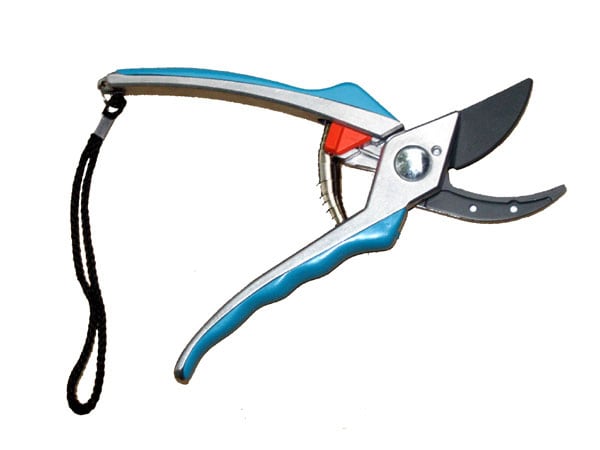
Hand pruners: You should know that many serious gardeners value these handheld cutters above all else — they carry these gadgets everywhere (in a special belt holster or tucked in their back pocket) and are reluctant to lend them. Why? A good pair fits your hand comfortably and takes care of a wide range of gardening jobs, from snipping off the spent stems from last year’s perennials to cutting roses for a vase to cutting away a pesky sucker to trimming a favorite shrub or ornamental tree. In a word, pruners are handy! You may see hand pruners called secateurs, especially in English publications. In general, hand pruners are intended for use on anything 1⁄2 to 3⁄4 of an inch in diameter (depending on the type) — which covers a lot of gardening cutting jobs, actually. If a branch is thicker, your pruners and your hands will strain and the pruners won’t be able to do a good job.
The best pruner handles are designed to absorb shock but are still lightweight and strong. Usually, they’re made of aluminum alloy and coated with a smooth, durable vinyl (usually red!). The more-expensive hand pruners come in leftand right-handed models.
As for the blades, you want tempered carbon steel. It’ll start off sharp and need to be resharpened by you or someone else (which is never expensive) from time to time to maintain the bevel, but it’ll hold up well and last a long time. You usually use a whetstone for sharpening, though you may be able to find gadgets made for sharpening pruners that can make the job much easier. Sometimes just replacing nicked up blades is easier. Better hand pruners have replacement cutting blades you can purchase. Here are some other considerations when you’re looking for a good hand pruner:
- If you’re investing in a good, professional-grade pruner, you may one day want to replace the blades rather than the entire tool, so discern now whether that’ll be possible.
- A safety latch is very important so the clippers don’t spring open when you don’t want them to, such as when they’re not in use or when they’re lodged in your pocket. A good pruner should click in and out of position easily, ideally with a flick of your thumb.
- The spring that holds the pivot, keeping it tense, should operate smoothly, without catching, without hesitation. Try it out a few times to make sure.
- Some clippers have a nice feature on the bottom blade, a groove that helps carry sap and pitch away from the tool. You should be in the habit of cleaning your pruners after every use anyway, but this little extra certainly helps.
- Bypass pruners: By far the most common, these pruners make neat, even, have-close slices, thanks to a beveled cutting blade.
- Anvil-style pruners: These pruners earn their name because the cutting blade comes down on a slender, non-cutting “anvil” blade, so a flush cut isn’t possible. This tool is right for cutting very tough or dead wood. Some anvil-style pruners have a ratcheting action, which makes cutting easier.

No comments:
Post a Comment